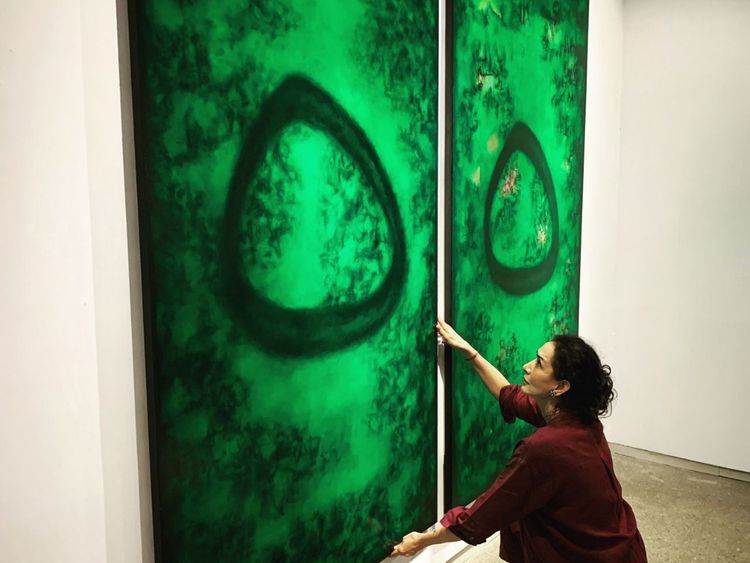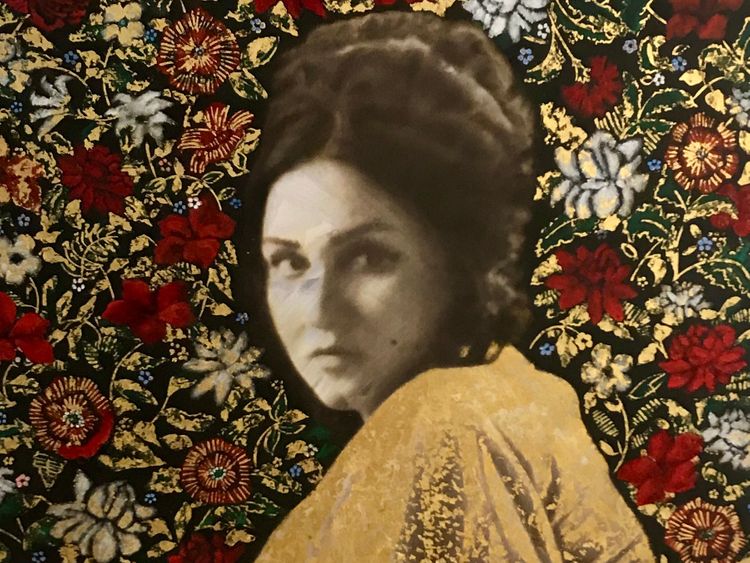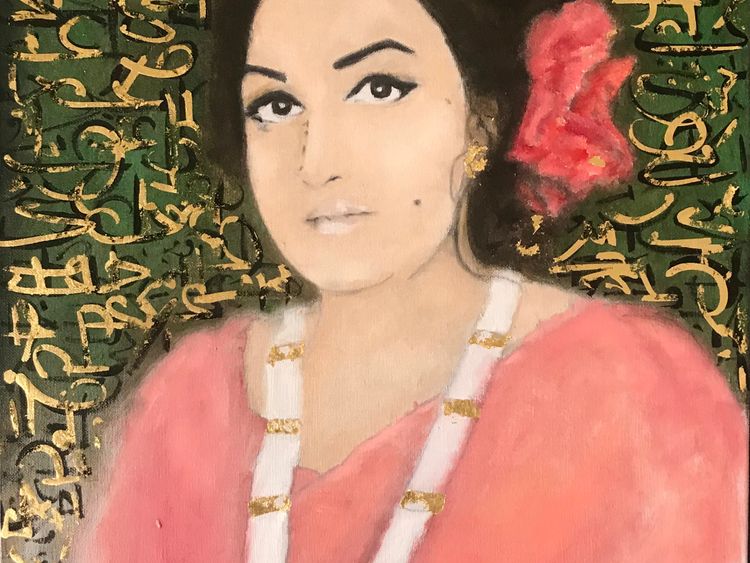
“Colour is like music. It is a deaf man’s music.”
So true are these words of Nazia Ejaz on viewing any of her paintings. Nazia Ejaz, one of Pakistan’s leading, most important artists, makes music and writes epics with her art. Her paintings are spellbinding. Magic is in her colours and imagery that comes with its own story, resplendent with a theme, plot, subplots, complexity, and an almost palpable sense of being in love with the creation of that story.
Fascination for art is not something unusual for Nazia, the youngest daughter of one of the subcontinent’s most iconic and most celebrated singers, Madam Noor Jehan, and Ejaz Durrani, one of Pakistan’s much-loved cinema stars, and a director and a producer from 1950s to 1980s.
BFA from Lahore’s National College of Art, and master’s degrees in visual arts from Slade School of Art, UCL, and Visual Art and Creative Practice from University of South Australia, Nazia studied Indian Art history with SOAS and Sotheby’s Institute, London. Her love for art is lifelong, vividly illustrated in every step of her life. Having worked as a printmaker, painter, and teacher in the UK, Australia, and Pakistan, Nazia, mother of two, is currently living and working in Karachi.
Nazia’s body of work—constant, stunning, evolving—spans over decades, 1992-2022 and continuing, with solo and group exhibitions at some of the leading art galleries in Pakistan, Australia, and the UK.
“Scriptures of Love”, shown at Canvas Gallery, Karachi, on November 16-25, 2021, is a magnificent display of the range and the depth of Nazia’s work, masterfully elaborated in the review of Quddus Mirza, a renowned Pakistani artist, art critic and art educator: “One is unable to decide or determine between the seductive and the spiritual while in front of Nazia Ejaz’s surfaces… [who] in her works seems to be exploring eastern philosophy, elements of religion and the essence of Sufism. Ejaz approaches these concepts through the language of an image-maker: a person who translates and transforms ideas into shapes, forms, and colours, hence expanding their impact, understanding and beauty.
Nazia Ejaz draws her inspiration from the Renaissance, but instead of replicating the past imagery, she invests in the brilliance of colour while producing paintings of almost abstract nature. Ejaz strives to compose her colours like notations of great music.
The melody of her art does not depend on parental references, nor on her readings on Islamic philosophy, but on an amalgamation of the past and the present, of East and West. It is cold pressed to the extent that what we get eventually is the purity of paint, and the pleasure of pushing boundaries of all sorts. Ejaz, for her part, refrains from any such, direct interpretation, because her work has the potential of being viewed through multiple, diverse perspectives.”
In 2019, Nazia’s series of paintings “Love Letters” was a beautiful tribute to her mother, Madam Noor Jehan, whose songs are everlasting odes to poetry and melody: “When I was at university in London in the 90s, I would get a letter from my mother, Noor Jehan, beautifully written in Urdu. As I sat reading in the corridor outside the Printmaking Department at the Slade School of Fine Art, my friends, passing by, would marvel at the beautiful script and asked for translations. They called them my love letters, and they were—full of emotion and prayers and longing.
There is a lot that one can say about Noor Jehan. At times, it is her songs that inspire, sometimes her photographs, and at other times, her words. She was a child protégé, a film star and singer par excellence, a style icon, a patriot, a friend, a mimic, and a mystic, as well as a single mother with a very strong work ethic and a sense of integrity. She worked in a male dominated industry and earned the respect of her peers and public at large. With every phase of her life, she seemed to have reinvented herself. She was melodramatic and unreasonable, warm, and generous. For me she was always a symbol of female empowerment.
With this body of work, I have tried to express something of my sense of her, some glimpses of my time with NJ. It is my love letter to the woman who has been the single most influential figure at every juncture of my life and work.”
Nazia, talking to me about her work, said: “Since 2015, the concept, metaphor and the physicality of ‘jaali’ has been the primary backdrop of my work. All the work I have done since 2015 is different offshoots of this idea. It controls the space and the view of the outside and the view of the inside. It demarcates, protects, and alters the view of inside and outside.”
For Gulf News, I asked Nazia Ejaz a few questions:
Mehr Tarar: What inspires you in your day-to-day life? Who are your greatest artistic inspirations?
Nazia Ejaz: Art is a translation of life through the medium of the artist. How an individual perceives and relates to the environment and to people has always interested me. The idea of connection and separation due to gender, race, or a social bias. My practice is an observation of life through my own experience. It is a contemplation of things that enhance and magnify the experience of being alive. It is interwoven with my own journey of self-awareness and self-actualisation. Sometimes the thoughts are far more developed than the work, but at other times, the work travels ahead of the understanding. It is very exciting for me at that point to see where it will lead me, what it will reveal.
Music has always inspired me. For me it is one of the strongest art forms in that it is able to transcend all barriers of points of separation and has a visceral effect on human beings. Colour, like music, is able to evoke an emotional response regardless of identity or language. I have been working with large scale colour canvases with a lifetime of words woven into them. The process of making, in this case, itself becomes a screen of introspection and contemplation in search of awareness and cognisance. It is a way of life, a way of looking and processing the world around me, rather than something I do.
Claude Cahun said in 1930: “Then, break the glass panes ... with the fragments, compose a stained glass.” I am very aware of the fact that I am standing on the shoulders of giants. All great artists that have gone before and left their work for us to learn from and to build upon. There are too many to name. And not just artists. Actors, musicians, writers, film makers, poets. All artists whose work has moved me are my mentors, and life my inspiration.
What is missing from the art world as it exists today? How do you see that void being filled?
All sorts of art and artists have existed always. ‘The art world’ that you are referring to, mainstream art, is a sort of spotlight that highlights a certain type of art form, or a certain type of artist, depending on what fits the agenda and interests of the time. And this focus keeps shifting. It moves from paintings to sculpture to installation to performance art and back again. But whether the spotlight is on it or not, all sorts of arts and artists exist and communicate and contribute. The art world is not a static thing. It is a moving, changing organism with as many objectives as there are people involved in it. As an artist my focus is on my work. I believe if the work is strong and true, nothing else matters. It speaks for itself.
How do you see yourself and your art evolving over the next five years? Next ten years?
It grows as I live and learn. It evolves with every experience I encounter. I think it is a privilege to be a practising artist. My practice is not only a way of communication for me but a source of learning and appreciation of life. It allows me to turn my focus inwards and to examine my ideas about life and perception of others. I am excited to see where the work leads me.
What advice, if any, would you give to young female artists searching for their voice?
In the words of the art critic Jerry Saltz “If you just get to work and share what you are really thinking with other people in your own voice, and you become as radical, as vulnerable as the work, you are looking at a life lived in Art.” This is a sound advice for any artist, male or female.












